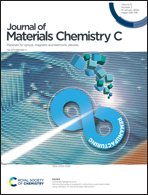Unusual red luminescence and super thermal stability of a new narrow-band emission phosphor for backlight display application†
Abstract
Resilient and consistent narrow-band red emitters are recognized as crucial facilitators for wide-color-gamut liquid crystal display (LCD) backlights. Herein, an emerging red phosphor, Ca3(BO3)2:Eu2+ (CBO:Eu2+), with narrow-band emission (full width at half maximum = 50 nm) and super thermal stability, is reported. It is worth noting that Eu2+-doped borate oxides usually emit blue light in general, but CBO:Eu2+ shows red emission centered at 640 nm under 465 nm blue-light emission. We deduce that its abnormal emission band is mainly due to the centroid shift and crystal field splitting. On the other hand, CBO:Eu2+ also exhibits anti-temperature-quenching (TQ) luminescence, that is, its integrated emission intensity at 200 °C is 102% that at 25 °C. Its unusual resistance to thermal quenching mainly relies on the rigid framework structure and the existence of energy traps. By employing the as-fabricated phosphor as a red color convector, a white LED backlight device with a wide color gamut (87% NTSC in CIE (1931) color space) was constructed. This finding not only provides a promising red phosphor candidate for application in excellent quality backlight displays, but also opens a new idea for exploring promising narrow-band red-emitting luminescent materials.



 Please wait while we load your content...
Please wait while we load your content...